I’m delighted to have been shortlisted for the “Best Blog of a Politician” by the Irish Blog Awards, yeah!!!! well done to the winner Dylan Haskins
see http://awards.ie/blogawards/ for more…
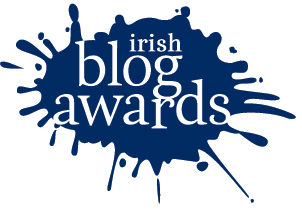
I’m delighted to have been shortlisted for the “Best Blog of a Politician” by the Irish Blog Awards, yeah!!!! well done to the winner Dylan Haskins
see http://awards.ie/blogawards/ for more…

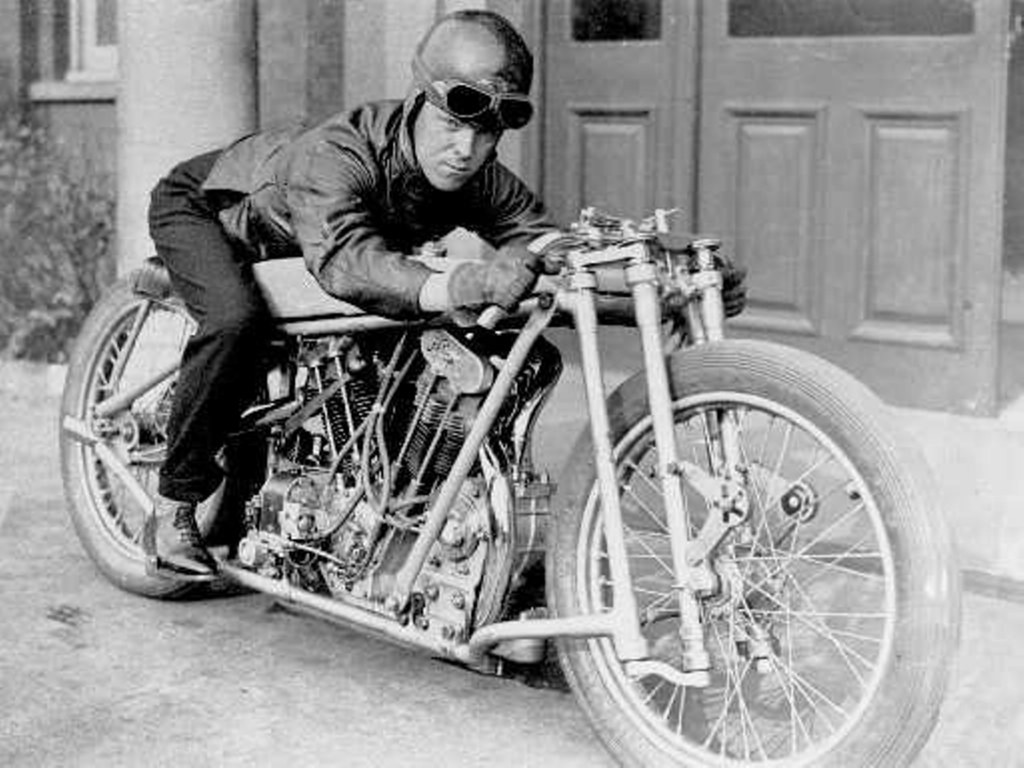
Kieran’s Our City, Our Town,
Cork Independent, 17 March 2011
In the Footsteps of St. Finbarre (Part 251)
The Wright Record
“A new world’s motor cycle speed record of 150.74 m.p.h was set up by J.S. Wright, the British Rider, on the Cork Carrigrohane Road yesterday. This speed beats the record of 137.61 miles per hour made in September by the German rider, Henne. The road has been pronounced the fastest road in Great Britain or Ireland” (Journalist, Irish Independent, 7 November 1930, p.9).
In a historical sense the Carrigrohane Straight Road, since its creation in the nineteenth century, has always played a key part in the life of the city. In the 1930s, it was well known for its motor cycle speed records and the Cork Motor Car Races of 1936-1938. The first major attempt to harness the two and a half mile concrete road for creating speed records was for a motor cycle speed meeting in 1929 at which speeds of a hundred miles per hour were attained. The first fastest motorcycle record was set unofficially by Glenn Curtiss in 1903. The first officially-sanctioned Fédération Internationale de Motocyclisme record was not set until 1920. In mid 1930, Joseph Wright of Britain lost the motor cycle speed record to Jacob Ernst Henne (BMW) of Germany. Later that year, plans were made to retake the record. The 1930 Motorcycle Exhibition at Olympia, London was coming up in the second week of November 1930 and it was generally felt it would be good for business if a British machine could regain the record.
English motor cycle manufacturers had held a monopoly of the world’s speed record for many years in the early twentieth century and there was consternation in English trade and sporting circles when the German rider Henne deprived England of the honour. J.A. Prestwich Industries was one such prominent English motor cycle manufacturer, which wished to provide an engine for the new record. Named after its founder John Alfred Prestwich (from Tottenham), the company produced cinematographic equipment, internal combustion engines (for which the company was generally abbreviated to “J.A.P.”), and other examples of precision engineering. Their engines were used in many famous motorcycle brands and other devices, such as early aeroplanes, chainsaws, and cultivators such as those produced by Howard Rotovators, and light rail maintenance trucks. During the Second World War J. A. Prestwich produced around 240,000 industrial petrol engines in support of the war effort, together with millions of aircraft parts, fuses, etc. Their motorcycle engines were associated with racing success and were still used in speedway bikes well into the 1960s.
A few days before the London Motorcycle Exhibition in early November 1930, the Cork and District Motor Club directed the organising bodies of the new record attempt by British interests to the Carrigrohane Straight Road. The road had a fine surface because of receiving an excellent cement surface in 1927. Joseph S Wright, one of Great Britain’s foremost motor cycle racers came to Cork to attempt a new record. French officials arrived in Cork with special electric timing apparatus. Lieutenant-Colonel Crerar was director of the test. The first attempt was on 5 November 1930 but was postponed owing to continuous rain and greasy conditions on the road. The trial took place the following day.
Joseph Wright rode a 1,000 cc Q.E.C. Temple J.A.P-engined machine and regained the record by clocking up at just over 150 miles per hour. Appearing in a British Pathé movie (http://www.britishpathe.com/record.php?id=4434), his clothing was strapped down to cut back on wind resistance. He even had tape put around his throat. He wore a streamlined motorcycle helmet. The film shows shots of the bike being towed behind a car to get up to starting speed.
The West Cork Motorcycle Club in their historical research notes that the bike was built by Claude Temple who had himself already broken the speed record for motorcycles in about 1927. It featured a supercharged 998cc V Twin JAP engine and front forks to the OEC patented design. They argue that there was a controversy at the time in which it was claimed the bike had in fact broken its engine on the first run and the record run was actually made on the back up Zenith-JAP. No one seems to be sure. The manufacturing of the Claude Temple company ended due to the Second World War Allied bombings, which devastated the factory forcing them to cease production. With out the capital to get the factory fully re-opened, the manufacturing totally ceased in 1954.
The Lord Mayor Frank J. Daly hosted representatives of J.A Prestwich and Co. Ltd and Joseph Wright at a dinner on the night of the record feat. In his address, he noted that “the government of the Free State was most anxious to foster and cater for anything that would help the Saorstát to keep its place amongst the nations of the earth”.
As for the record, it was retaken by the German Jacob Ernst Henne two years later in Hungary. Between 1928 to 1937, he achieved a total of 76 land speed world records, the last on November 28, 1937 with 279.5 km/h (173.7 mph) on a fully-faired 500cc supercharged BMW. This record stood for 14 years.
To be continued…
Captions:
582a. Joseph S. Wright, 1933 in Lancastershire (source: Boole Library, UCC)
582b. Preparing at the Carrigrohane Straight Road on 6 November 1930 (source: T.W. Murphy)
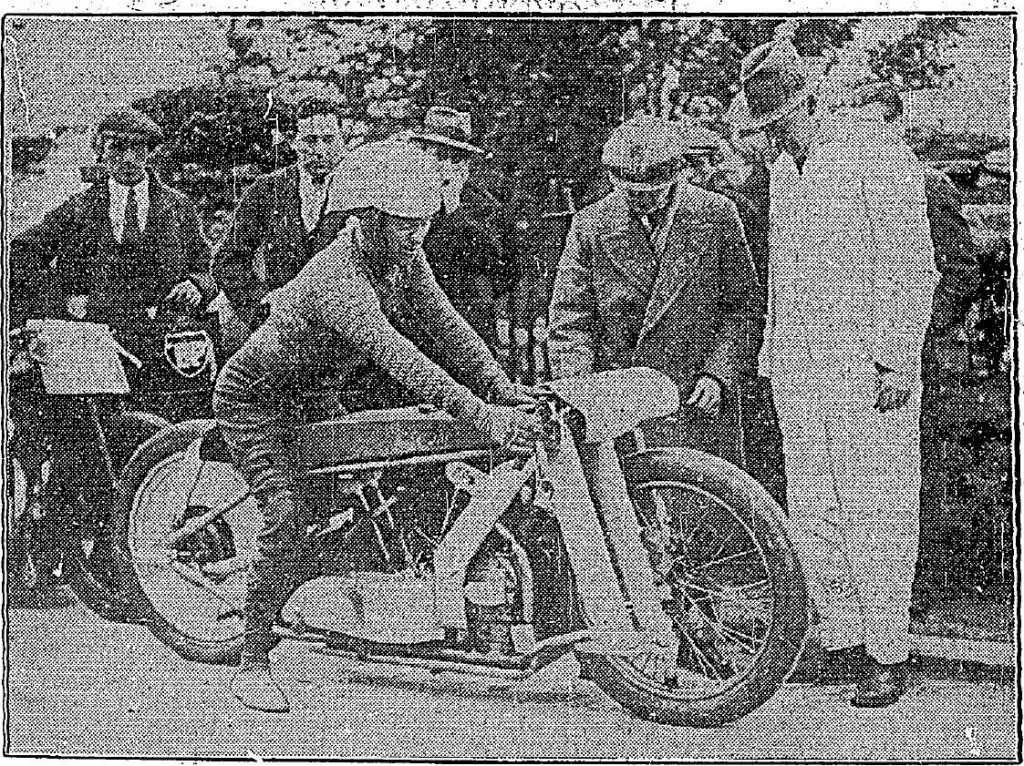
I welcome the Resident Participation Report and complement the Housing Directorate on this programme and Donal Guerin on his work. Civic participation is highly important in creating a sense of place, pride and identity in the city. The Resident Participation programme has hit a number of issues, which need to be looked at –
(1) difficulties in getting residents to overcome concerns such as victimisation, lack of time and a perception that other residents will let committee members do all the work
(2) difficulties with racism toward tenants
(3) difficulties with anti-social behaviour by young people
and (4) and a need for developing opportunities for resident groups to take more responsibility for their environment.
These are issues that the Council need to continue to look at and the new central government needs to look at seriously.
I would like to see a proper civic engagement inititaive like the Green Flag environment programmes in our schools. We expect people to go on committees where they have no background or exposure during their education at all to committee or even community work.
I agree with the directors report that we have to build upon the success of the community events on Bonfire night. But we ultimately need to do more with regard to protecting our green spaces in the city on this night.
We have approx 101 festival days in Cork City; one of those days unravels all the good work associated with the other 100 positive festival days. It’s not good enough that Cork makes national television news for this annual terrorism festival and gets no major coverage for the other 100 days.
Motions:
To get a report on why BAM construction have not removed their hoarding erected on Penrose Quay? (Cllr Kieran McCarthy)
As per a previous motion in mid 2009, to ask the relevant directorate, when is the area around the town wall under the ramp under Kyrl’s Quay going to be cleaned up? (Cllr Kieran McCarthy)
Question to the City Manager:
To ask the manager about an update on the revamp of Christ Church and the redesign of the adjoining section of Bishop Lucey Park? (Cllr Kieran McCarthy)
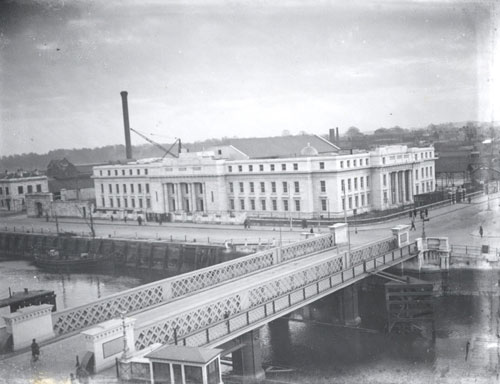
I was delighted to be able to deputise last Thursday (10 March 2011) and receive in the Lord Mayor’s Chamber the Chargee d’Affaires, Ms. Alicia Kerber of the Mexican Embassy in Ireland. We spoke about Mexico’s connection to Ireland and the future plans the embasy have. We then attended the opening in UCC of a travelling photographic exhibition across the globe called 360 degrees by Ruben Ochoa. For the Cork leg, the exhibition is being hosted in the Department for Hispanic Studies in the O’Rahilly Building in UCC until the end of March.
For more on Ruben’s work, click on the link, http://www.rubenochoa.com/
UCC’s write up:
http://www.ucc.ie/en/news/fullstory-118281-en.html


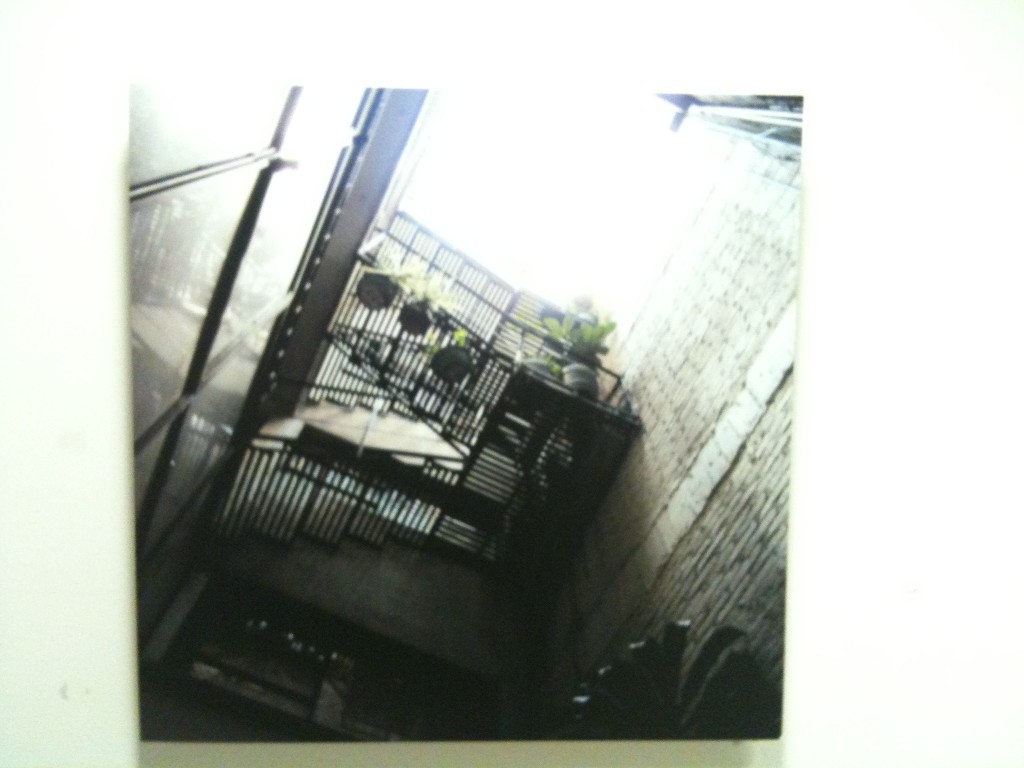
Kieran’s launch speech:
Ms Kerber, Professor Finneran, Ladies and Gentlemen, Ruben Ochoa. On behalf of the Lord Mayor, many thanks for the invitation to come and chat to you this evening.
They say that art has the power to stop, impress, make one question, wonder, dream, remember, be disturbed, explore and not forget – a whole series of emotions – all of which echo throughout Ruben’s photographs. Walking around one can see the amount of work that has been put into the photography on display.
What is very evident is the amount of planning, design work, thought, emotion and building work that has gone into these photographs. While these images speak volumes to the photograph lover, the quality, detail and narrative work gives Ruben’s a much broader appeal. Anyone who appreciates the processes of photography, the freeze framing of landscapes, people and their way of life cannot but be drawn in – taken on a journey looking at Ruben’s work.
Journeys through Landscape:
As a student geographer in the Department of Geography near here my own interests have been for some many years exploring Irish culture, history, landscape and identity making. I have a passion for exploring Cork City and its region’s rich historical tapestry which to me is an enormous and complex artwork, which has its own lines, contours and outward expression, meanings and memories.
Ruben’s photograph before us also zoom in on what could be described a piece of life – his photographs create new ways of seeing places, create ways of expressing ideas about the idea of place and create new ways of place making which ultimately, the photographs before do through the act of photographing.
Each of Ruben’s work presents a different view but are all connected in some way; each work has its own meanings and memories to him and of course one can say all of that for all those who come to view his works. Each viewer will take something different away from their visit to view his work.
The Power of Landscape:
Perhaps one of the central threads to Ruben’s work is the power of landscape – his works on display fluctuate between views of bits of buildings and views of people. Ruben seems to be an explorer of place, physically, culturally and imaginatively. He seems to be mesmorised and empowered to react to the narratives – memories and life within landscapes and this draws him closer to his subjects of study. It is clear that landscapes have affected him in different ways. It has slowed him down to observe, ponder and react to its details.
He seems to be continually learning how to see, read, understand and to appreciate the landscape. However, with all of the complexities of place-making people like Ruben’s work also presents complexities and cannot be pinned down – Ruben is an installation artist, photographer and much more.
The landscapes Ruben engages with, have changed his perception, his beliefs, his worldviews and his journey through life.
It’s clear that for Ruben that perhaps landscape infects him with a longing for it. He presents a multitude of views, very close-up and wide pan shots that present landscape as random and messy but beautiful.
His study of the interface of human and the landscape elements seems also enhanced by wider spatial settings. He presents views changed through weather and its changing moods. It’s like the landscape can change its humour and colour. He explores the resulting and varied colour palettes of places…. that can create a different texture forming a new rhythm and pulse for a place’s identity. So yep for Ruben, landscape with all its strengths and weakness perhaps is a genius which he continues to chat to. It engages, inspires, pushes him on and moulds him.
Looking, listening and moving:
His photographs as memories light up his canvasses – every story presented is charged with that emotional sense of nostalgia –the past shaping his present thoughts, ideas and actions.
It is said that a place owes its character not only to the experiences it affords –sights and sounds – but also to what is done there – looking, listening and moving. The association between places of meaningful locations and people and actions is often invisible because it is so deeply engrained. In otherwords, the familiar can be forgotten. Ruben explores the richness in the ordinary if one looks, listens and observes.
Haunted images:
All of what I have noted are ideas. They plus many more ideas certainly haunt Ruben’s own journey in the landscape, physical and imaginative he travels through; but those ideas are not set in stone.
But what is quite clear is that Ruben has explored, explores and will continue to explore different ways of looking at what’s in front of us. Perhaps for us the viewer, he presents a set of lenses or tools perhaps to decode, discover, recognise, reveal, synthesise, communicate, move forward and explore cultural heritage, the environment, society and the very essence of identity-making.
Ladies and gentlemen, in this world, we need more of those traits; of thinking outside of the box – more confidence, strength of imagination, freedom to express oneself, determination, force of life – and we need to mass produce these qualities.
Ruben, may you always have an open mind to ideas, people and places and that your talent will grow with each work. I wish you all the best of luck this week and moving forward into the future as you cross Europe and beyond with your work.
It is my great pleasure to launch your art exhibition.
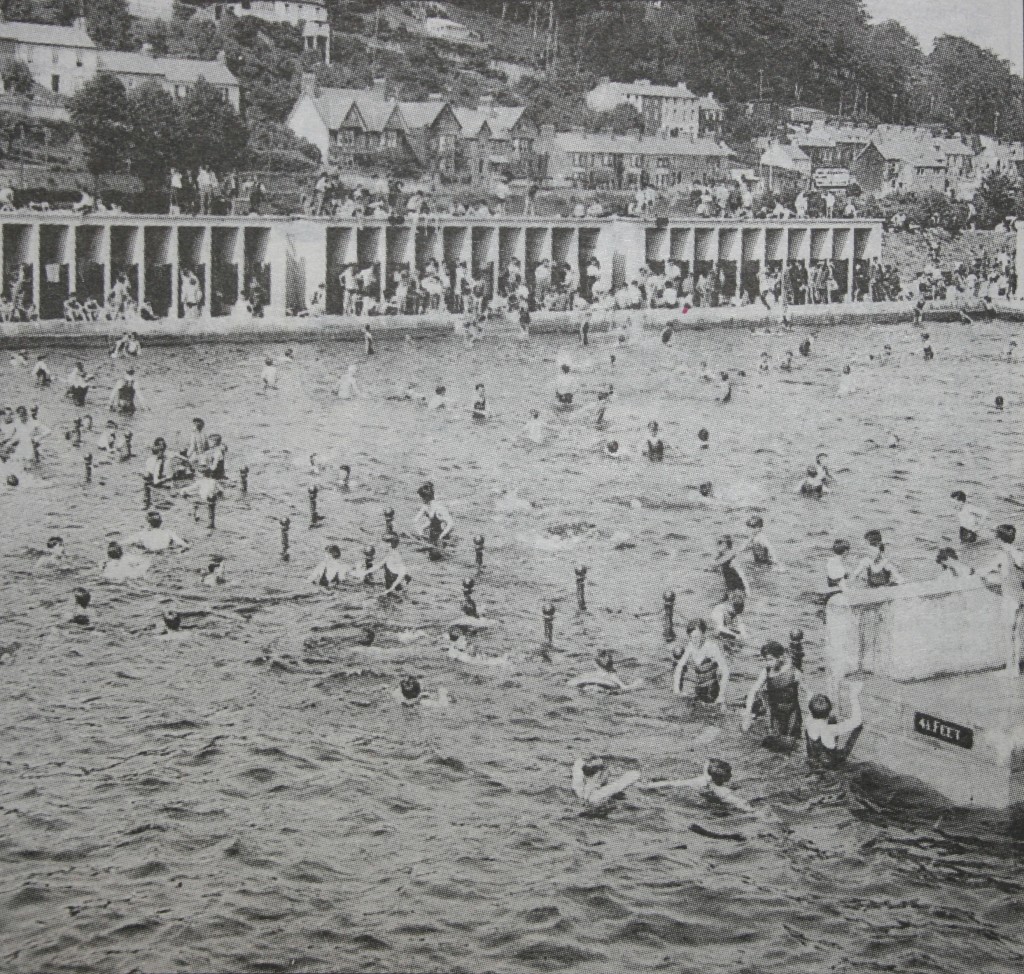
Kieran’s Our City, Our Town,
Cork Independent, 10 March 2011
In the Footsteps of St. Finbarre (Part 250)
Cork’s Proudest Possession
“I hope for many years this pool will be a pool of strength, a pool of healthfulness and open air life for the people of Cork. I have pleasure in congratulating the people of its possession and those who are responsible for it, on the good job they have done; may it remain for a long time one of the proudest possessions of the City of Cork” (Hugo V Flinn TD, Cork Examiner, 21 June 1934 on officially opening the Lee Baths)”.
Eighteen months after the closure of the Irish Industrial and Agricultural Fair, the summer of 1934 coincided with the opening of Cork’s new municipal and open-air unheated swimming pool on the Lee Fields. Billed as one of the largest of its type in Ireland, it was officially opened on Wednesday afternoon, 20 June 1934 by Mr Hugo V Flinn T.D., Parliamentary Secretary to the Minister for Finance.
The Cork Examiner highlights several reasons for its construction especially the city’s enormous unemployment problems. The City Manager Philip Monahan set out to create an enterprise of considerable magnitude, which would have in it a large labour content for even the unskilled labourer, plus create a municipal project that would have social and economic value. In the wider context, Monahan was probably well aware of the growing interest internationally in swimming and how the popularity of swimming pools was spreading. Oliver Merrington, in his work on the history of open air swimming pools, records that over 37 such pools opened in the UK in the 1930s. In Cork, the Eglington Street Baths (which were opened in 1901) could not accommodate the growing numbers of swimming enthusiasts.
The Lee Baths cost £23,000 and part of this was paid for by central government whilst the rest was paid for by Corporation bank loans. In a positive sense 75 per cent of £23,000 was spent on wages. Another issue was where the building was to be erected outside the confines of the city boundaries. That was dealt with the assistance of legal teams between Cork Corporation and Cork County Council. The Corporation also sought advice from Mr J Weldon, President of the Munster Branch of the IASA. Resident Corporation engineer Patrick J Harrington was in charge of the construction whilst Mr. Stephen W. Farrington attended to the concrete design.
According to the Dictionary of Irish Architects, Stephen Farrington (1889-1965) was Cork City Engineer from 1924-1958 and in a sense was a right hand man to Philip Monahan for four decades overseeing and engineering in particular the design of the new suburban local authority housing schemes. Farrington was born in Cork City circa 1889 and came from a distinguished Cork Presbyterian family. He studied at Cork University, where he obtained BA and ME degrees. After graduating he worked for a time in Northern Ireland, first with Belfast Corporation, then with the Belfast & Co. Down Railway, and finally as town surveyor of Lisburn, Co. Antrim. In 1924 he was appointed city engineer of Cork, a post which he held until his retirement in 1958. For many years Farrington lectured on municipal engineering at University College, Cork. A fluent speaker of Irish and French, he was an active member the Cork Literary and Scientific Society. He was also a keen sportsman, which in part also probably influenced the creation of the Lee Baths.
The inaugural gala at the Lee Baths took place after the official opening 20 June 1934. Witnessing the events was the Lord Mayor Ald. Sean French, Hugh V Flinn T.D. and other guests. Competitors compared the new site favourably with the Eglinton Street Baths and spectators commented on their spacious accommodation. The programme comprised schoolboy, junior and senior squadron races, a polo match and several novelty events; The schoolboys squadron race was won by Christian Brothers College and second went to Presentation Brothers College. The junior squadron race was won by the Republican Swimming Club, second by Sunday’s Well and third place by Dolphin. The senior squadron race was won by Sunday’s Well, second by Dolphin and third by Highfield. A lifesaving exhibition was given by R Bogan and P Renouf. In the senior polo challenge match, Sunday’s Well were defeated by Dolphin by five goals to one. In the swimming, a number of strokes were demonstrated from breaststroke, lifesaving backstroke, over arm sidestroke, trudgeon stroke, trudgeon crawl, back crawl and dual rhythm crawl.
In the early years, women were not allowed to swim in the Lee Baths. The Cork Examiner’s record of the opening day highlights a letter of protest against the exclusion of ladies at the baths; seventy signatures were attached to it, the majority of which were women; others included that of a TD. They claimed that the Corporation was abusing its authority by prohibiting a large section of the population from bathing at the Lee Baths. Their letter gave the example of equality at the open air pools at Blackrock and Dalkey in Dublin Dun Laoghaire, Bangor, Portrush, Armagh,Warrenspoint and Newcastle. They asked for restrictions to be lifted at the Eglinton Street Baths and for the entire use of those baths during the summer months for women. Their requests were not met.
To be continued… I’m looking for memories of the Lee Baths, any help much appreciated…
Captions:
581a. Photograph from Cork Corporation 1934 diary of the Lee Baths (source: Cork City Library)
581b. Section of 1948 ordnance survey map of Lee Fields showing the Lee Baths (source: Cork City Library)
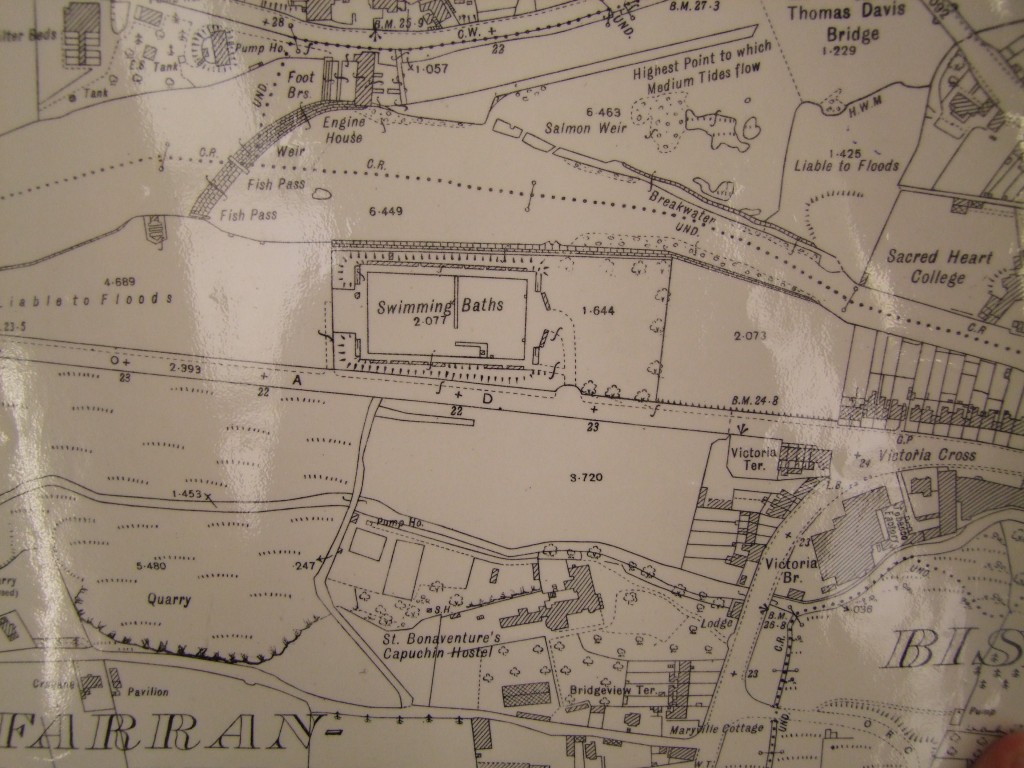
Last night (Sunday 6 March 2011) I had the pleasure of deputising for the Lord Mayor and opening the 22nd Cork French Film Festival at the Cork Vision Centre; Very well done to all the organisers, check out http://www.corkfrenchfilmfestival.com/
Kieran’s Comments at the
Launch of the Cork French Film Festival, 2011
Eye on France
French Ambassador, members of the film commitee, sponsors, John X Miller, ladies and gentleman, it’s a great pleasure to be at the launch of one of Ireland’s key film festivals, the Cork French Film Festival this evening.
France is the birthplace of cinema and was responsible for many of its early significant contributions. The French film industry in the late 19th Century and early 20th Century was among the world’s most important. Auguste and Louis Lumière invented the cinématographe and their L’Arrivée d’un train en gare de La Ciotat in Paris in 1895 is considered by many historians as the official birth of cinematography.
France has a strong indigenous film tradition; France has also been a gathering spot for artists from across Europe and the world. For this reason, French cinema is sometimes intertwined with the cinema of foreign nations. Directors from nations such as Poland, Russia as prominent in the ranks of French cinema as native Frenchmen. French directors have been important in the development of cinema in other countries, such as in the United States. It is noted for having a particularly strong film industry, due in part to protections afforded by the French government.
Nouvelle Vague and Cléo from 5 to 7:
Tonight the programme commences with a screening of Cléo from 5 to 7 directed by Agnes Varda in 1962. The story starts with a young singer, Florence “Cléo” Victoire, at 5PM June 21, as she waits until 7PM to hear the results of her cancer test. The film is noted for its handling of several of the themes of existentialism, including discussions of mortality, the idea of despair, and leading a meaningful life. Agnes’s movies, photographs, and art installations have often focussed on documentary realism, feminist issues, and social commentary — with a distinct experimental style. And it is not for me to try and pin down an artist to a genre.
Especially as Agnes and many others way back over 50 years ago tried to break the mould of traditional cinema plus influenced the growth of Nouvelle Vague.
Many like Agnes in the 1950s and 1960s attempted to engage in their work with the social and political upheavals of the era, making their radical experiments with editing, visual style and narrative part of a general break with the conservative paradigm.
The movement has its roots in rebellion against the reliance on past forms, criticizing in particular the way these forms could force the audience to submit to a dictatorial plot-line.
New Wave critics and directors studied the work of western classics and applied new avant garde stylistic direction. The low-budget approach helped filmmakers get at the essential art form and find what was, to them, a much more comfortable and honest form of production.
These movies featured existential themes, such as stressing the individual and the acceptance of the absurdity of human existence.
Likewise, the influence of the movement was seen in a number of other national cinemas globally – beginning in the 1960s, and continuing to the present day. Similar movements arose in a number of European countries and further afield to Japan.
People like Agnes cannot be pinned down – she is director, screenwriter, editor, actor, producer, installation artist, photographer and much more.
And perhaps that is why her presence is so very apt today especially if we connect it into Ireland’s story. Once again Ireland has come to a cross-roads where it must now once again be creative and think outside of the box, so the nation can move forward.
Film and motivation:
The medium of film power has the power to grasp, encourage wonder, inspire confidence, motivate a self-purpose, provoke questions and the imagination and even draw in the viewer and even disturb and so much more – lessons of life can be presented and debated. Unlike music or theatre, a movie can show different aspects of the society. And the full diversity of French film is covered in the programme in our City.
I have no doubt for many of those present to view Cork’s French Film Festival, you already have a love of film and even art house cinema. Ladies and gentlemen perhaps there is so much to learn through the medium of film – Actors and directors all bring their own talents, confidence self pride, self belief and a desire to perform their medium. Those are all very important traits
Ladies and gentlemen, in this world, we need more of such confidence, pride and belief – we need to mass produce these qualities, all of which these films stand for
I would also like to thank all of the grant aided bodies and sponsors who saw the opportunity to bring a taste of international culture to Cork. But I encourage all of us to keep watching, praising, critiqing and even giving our own direction to what not only film genres we should watch but also how film can be harnessed to nurture people’s motivations.
This is where film gives hope and have no doubt has saved souls.
I wish to congratulate all involved in the festival and wish the festival all the best for the future. And to the cinema goer, keep watching!
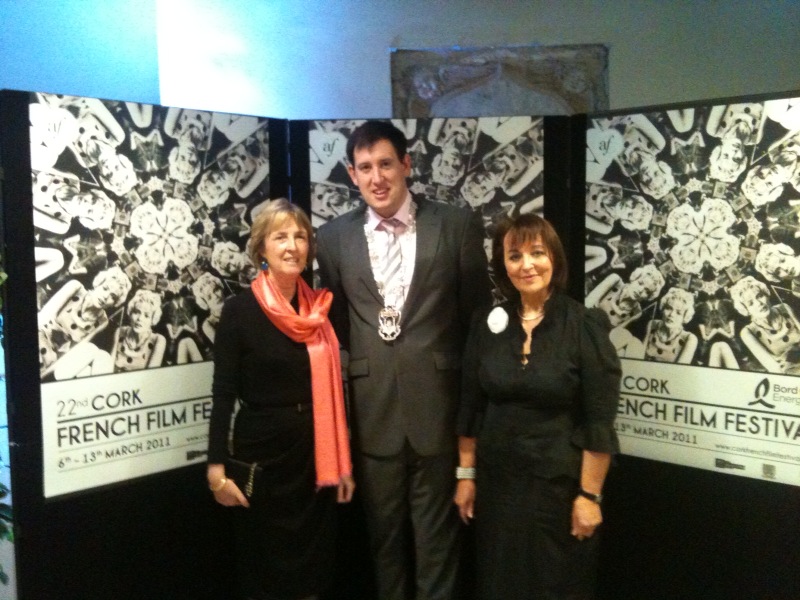
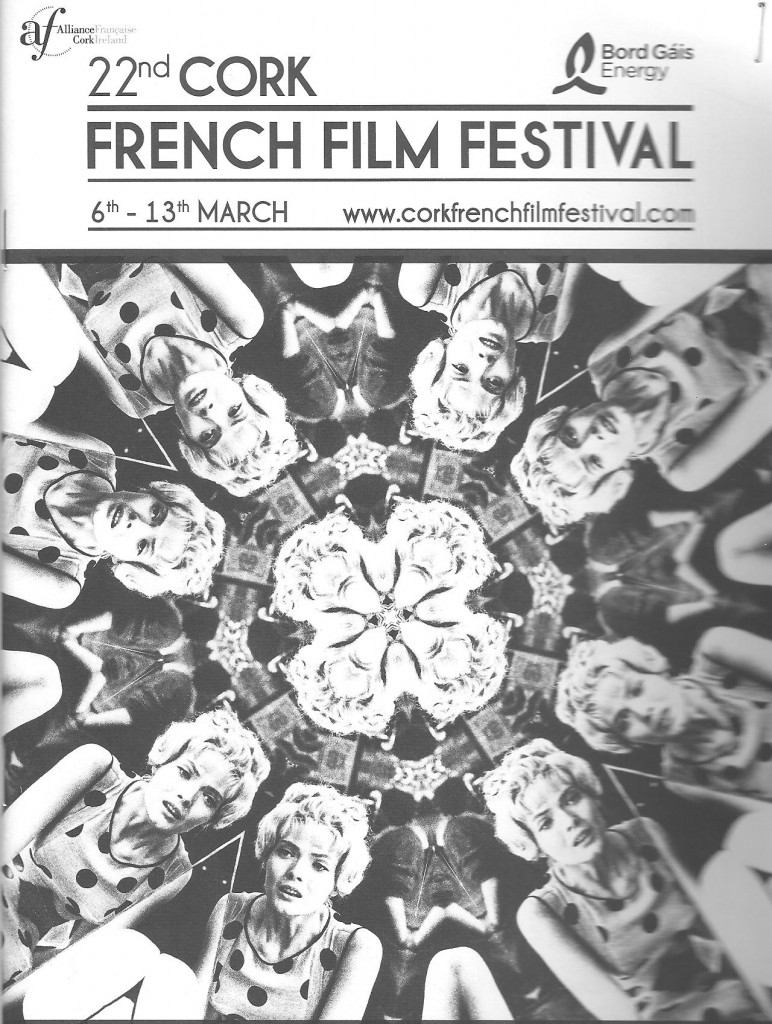
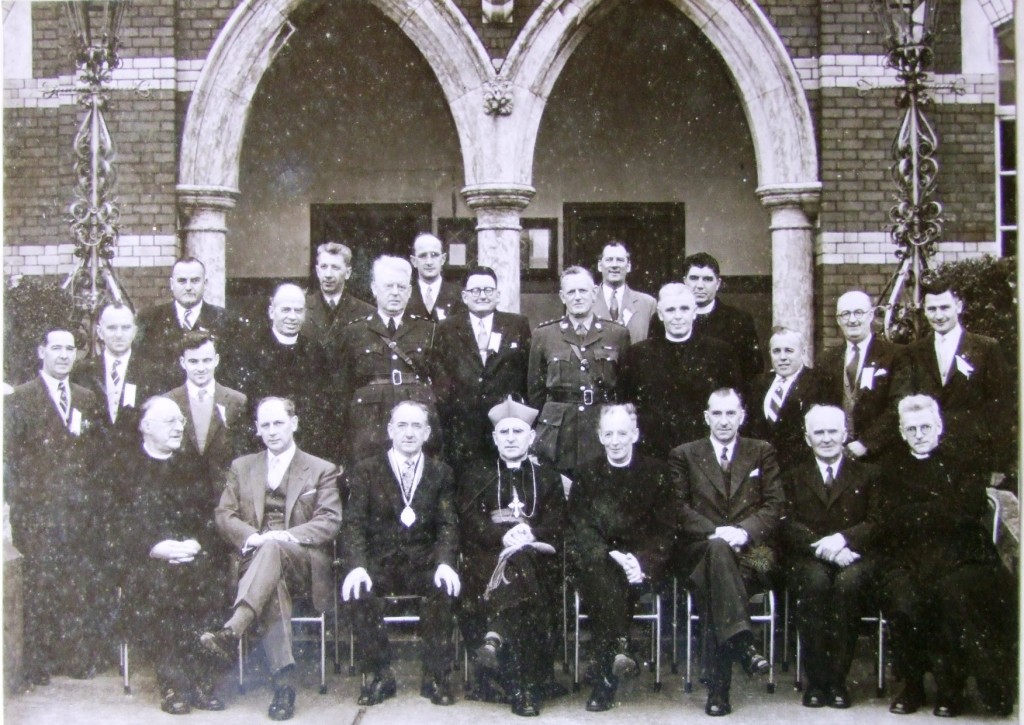
Kieran’s Our City, Our Town Article
Cork Independent, 3 March 2011
Coming of Age
This year Cork celebrates 200 years of the North Monastery or the North Mon School being opened in 1811. Recently, I was privileged to be able to speak at the first commemoration event and wanted to write something in this column to mark the centenary as well.
At the beginning, I can’t speak from being a North Mon boy but like many people I have personal connections to this great school. Hanging on the wall next to my stairs at home is a picture taken in 1958 of several past pupils of a class from the North Mon. In the centre of the photograph is my grandfather, Donal Sexton – his former classmates were Jack Lynch, Tadgh Carey of UCC, Gus Healy of Cork Corporation, Lt. Collins Powell, nephew of Michael Collins – all distinguished Corkonians in their own right – each of whom made their mark on this city and further afield.
The picture has remained in position in my house since 1958 next to the sacred heart picture and the coat stand – in a sense illuminating every exit and entrance from my house for 53 years. The caption of the picture is entitled Coming of Age, which is also quite an apt title to describe a 200 year celebration. The North Mon has once more has reached a milestone in its life, which rightly needs to be reflected on. Two hundred years of the North Mon is a really long time made up of thousands of young people, teachers, comings and goings and many a debate about the future of different generations. The North Mon is a place deeply rooted in Cork’s cultural identity. Indeed one is dealing with a long standing culture of hard slog, struggle, hardship, discipline, ambition and determination that has brought the North Mon to this point in its life. It has been no easy road.
The picture on my hall wall is just one picture that shines a light on past pupils and past experiences. A glance through the old roll books also reveals thousands of names of students that attended there. One cannot avoid thinking of all the trials and tribulations of past students and teachers who are not on any role of honour and who came through the school. All those that passed through its doors have given the place a continuity and have kept values going and standards high. Perhaps one can ask the big question, how many of these young people’s lives were saved through their attendance at the North Mon? How many were inspired to make a difference, to use their talents?
The North Mon School was established as a response to rampant poverty in the city. Way back 200 years ago John Carr, an Englishman, a travel writer of sorts in 1805, describes Cork’s economic fabric and social life. Cork was the largest butchery in Ireland and living conditions for the poorer classes in Cork were terrible and shocking. Many of the impoverished homes were located in narrow lanes and varied from cabins to cellars. It was realised in the early 1800s that the above problems could not be stopped but could be controlled as best as possible. Charity and education were key to curtailing some of the poverty. The North Monastery School was founded on 9 November 1811 when two Christian Brothers Brother Jerome O’Connor and Brother John Baptist Leonard were given charge of a school in Chapel Lane by the North Cathedral by the Bishop of Cork, Rev. Dr. Moylan. Seventeen students attended on the first day. In 1814 a fourteen acre sloping site was acquired from a wealthy catholic businessman, Sir George Gould Bart, and a new school was built. The North Monastery had found its permanent home. For the teachers in those days, it would have been no easy task and one of hard slog and hardship. Education and opportunity for them would have become mainly about giving relief, hope, dignity and faith. There were days of darkness and frustration and I have no doubt days of light.
During the difficult days of the late nineteenth century, three individuals brought the school to another level of contribution to Cork society more so than a response to poverty. The North Mon was to become a place of literary thought, experimentation and invention. Br. Gerald Griffin, the celebrated poet and novelist became a member of the North Monastery in 1839. In 1857 Br. James Dominic Burke arrived at the North Monastery and under his guidance the students began the study of natural philosophy (science). Br. Burke is widely acknowledged as the father of vocational education in Ireland and made the North Mon a centre of excellence in scientific and technical education. At this time Br. John P. Holland (inventor of the submarine) studied in the ‘Mon’ under the guidance of Br. Burke. These three individuals would provide the creative foundations for the North Mon going forward.
As a Corkman, I’d like to say thank you to the North Mon and all it stands for, for its contribution to Cork and Irish society. Here’s to the next 200!
Check out North Mon Past Pupils on Facebook plus check out their bicentenary book for more memories of the school.
Captions:
580a. North Monastery Past Pupils Union “Coming of Age”, 19 April 1958
Back row; D. Cullinane, Prof. T. Carey, UCC, A.O’Mahony, K.V. Downing, Rev. D. Canon Connolly; Third row: Rev. J. Canon Kelly, Chief Sup. Dowd, Donal Sexton, Lt. Col. Collins Powell, Rev. Br. Nolan; Second Row: W.V. Dynan, Hon. Secretary, M. O’Brien, Hon. Treasurer, S. O’Connell, A.A. Healy, T.D., P.J. O’Leary, Vice President, C. Young; First row: R.Br. Clancy, Superior General, J. Lynch, Minister for Education, C. Murphy, President, North Mon Past Pupils Union, Bishop Dr. C. Lucey, Br. Mc Conville, Ald. R.V. Jago, Prof. H. St. J. Atkins, Br. O’Brien (picture: K. McCarthy)
580b. Brother James Dominic Burke (picture: North Mon, Cork)
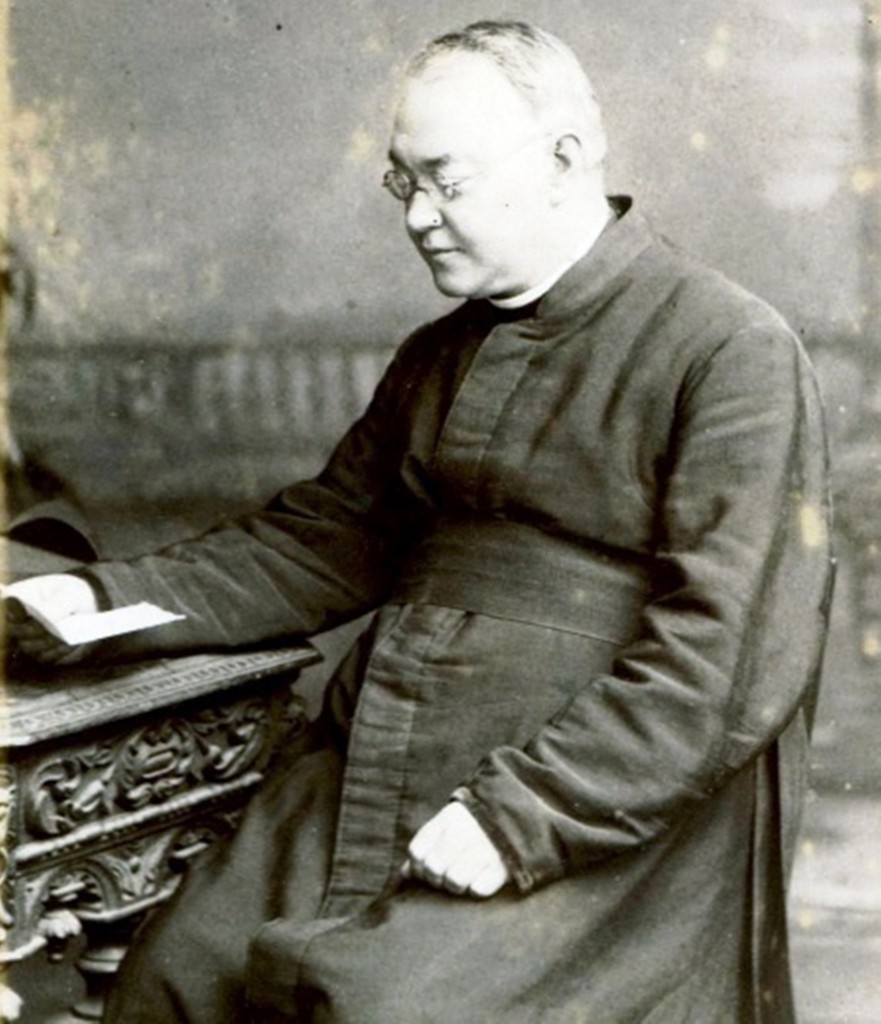
I would like to welcome the Council’s interventions here and acknowledge the hard work of Pat Ruane and Jeremy Ward.
The building at no. 5 Grenville Place has been vacant for a period of at least ten years and suffered from neglect and then collapsed.
The same thing happened it seemed last week on Kyle Street and before that Castle Street.
Lord Mayor, I’m worried about the strength of our Building Control unit. Over the last year, three buildings have now collapsed within a short space of each other. I worried about health and safety with such structures collapsing. And that’s not scare-mongering that’s being realistic plus I’d like to call for a swot analysis from that unit on what is going on.
I suppose on the heritage and history front; on one level, old nineteenth century buildings are all over the place in Cork and the vast majority are protected structures. But I still worry in how we don’t market and harness some of the key buildings of Cork’s built heritage – on a bigger scale, I could talk on about places such as the old Butter Exchange, which I have not seen a decent plan yet to really make it a centre piece of tourism in the Shandon area and in the city; I also worry and could also talk about Elizabeth Fort and its surrounding heritage and the challenges facing that 400 year old fort.
But here is a house where George Boole and eminent Mathematician lived.
Born in Lincoln, Boole went on to be an English mathematician and philosopher.
As the inventor of Boolean logic—the basis of modern digital computer logic—Boole is regarded in hindsight as a founder of the field of computer science.

Way back in 1849, he came to Cork to be the first professor of mathematics of then Queen’s College, Cork in Ireland (now University College Cork, (where the library, underground lecture theatre complex and the Boole Centre for Research in Informatics are named in his honour).
Living on Grenville Place, his mathematical skills were fully realized.
Boole approached logic in a new way reducing it to a simple algebra, incorporating logic into mathematics. He also worked on differential equations, the calculus of finite differences and general methods in probability
.
The 8 year stretch from 1847 to 1854 possibility when he was living at Grenville Place starts and ends with Boole’s two books on mathematical logic. In addition Boole published 24 more papers on traditional mathematics during this period, while only one paper was written on logic,. He was awarded an honorary degree by the University of Dublin in 1851, and this was the title that he used beside his name in his 1854 book on logic- Mathematical Analysis of Logic and his 1854 book, Laws of Thought..
During the last 10 years of his career, from 1855 to 1864, Boole published 17 papers on mathematics and two mathematics books, one on differential equations and one on difference equations. Both books were considered state of the art and used for instruction at Cambridge. Also during this time significant honors came in:
|
1857 |
Fellowship of the Royal Society |
|
1858 |
Honorary Member of the Cambridge Philosophical Society |
|
1859 |
Honorary Degree of DCL, honoris causa from Oxford |
Unfortunately his keen sense of duty led to his walking through a rainstorm in late 1864, and then lecturing in wet clothes. Not long afterwards, on December 8, 1864 in Ballintemple, County Cork, Ireland, he died of pneumonia, at the age of 49. Another paper on mathematics and a revised book on differential equations, giving considerable attention to singular solutions, were published post mortem.
In time Boole’s work formed the basis of mechanisms and processes in the real world and that it is therefore highly relevant. The use of Booles Boolean algebra could optimize the design of systems of electromechanical relays,his basic ideas underly all modern electronic digital computers.
The crater Boole on the Moon is named in his honour.
So in terms of the history of Boole’s House, we are dealing with something richly steeped in research and pushing forward the discipline of maths.
The Grenville Site is another example of how this city is not good at engaging and harnessing its history, its built heritage and minding it.
To conclude
I would like to observe that this city needs to (a) review the effectiveness of our Building Control Unit and (b) invest more in the harnessing of the city’s history, otherwise, the memory of such people as George Boole will disappear from this city with others – we’ll have a city with no uniquenesses and we’ll have a generic looking city that looks like any other city in the world.
thanks


